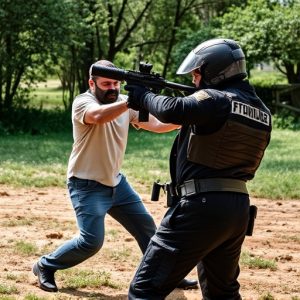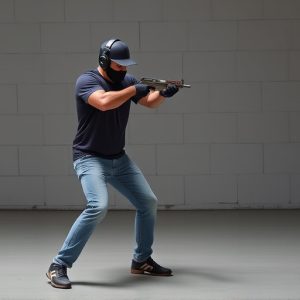Mastering Non-Lethal Weapon Training: Certification Guide & Stun Gun Charging
Non-lethal weapon training certification equips individuals to deploy and manage non-deadly force to…….
Non-lethal weapon training certification equips individuals to deploy and manage non-deadly force tools safely and effectively, such as charging stun guns correctly. To obtain certification, applicants must meet eligibility criteria, learn model-specific safety protocols, and complete theoretical learning & practical skills assessments. Comprehensive programs emphasize de-escalation, crisis management, and tactical decision-making for responsible use in real-world scenarios. Proper charging techniques ensure stun guns are operational and ready for self-defense or emergency situations.
“Unleash control with confidence. Discover the power of non-lethal weapon training and its escalating importance in law enforcement and personal safety. This comprehensive guide delves into the ins and outs of obtaining a certification, covering eligibility criteria and a step-by-step process.
From essential skills to specialized knowledge, learn how to navigate this unique field. Plus, gain expert insights on charging a stun gun properly – a vital skill for any responsible owner. Master these techniques and become a well-informed guardian of your safety.”
- Understanding Non-Lethal Weapon Training and Its Importance
- Eligibility Requirements for Certification
- The Process of Obtaining a Certification
- Key Skills and Knowledge Gained Through Training
- Charging a Stun Gun Properly: A Step-by-Step Guide
Understanding Non-Lethal Weapon Training and Its Importance
Non-lethal weapon training certification equips individuals with the knowledge and skills necessary to deploy and manage non-deadly force tools effectively. These weapons, like stun guns, are designed to incapacitate or temporarily disable a target without causing permanent harm. Understanding how to charge a stun gun properly is crucial in this context. It’s not merely about knowing the device’s mechanics but also mastering safe handling procedures to ensure their effectiveness during emergencies or self-defense scenarios.
The importance of such training extends beyond personal safety. It fosters responsible citizenry, enabling individuals to respond appropriately when faced with potentially dangerous situations. Proper certification encourages the ethical use of non-lethal force, minimizing collateral damage and de-escalating conflicts. Moreover, it empowers people to protect themselves and others without resorting to lethal means.
Eligibility Requirements for Certification
To be eligible for non-lethal weapon training certification, individuals must meet specific criteria set by regulatory bodies and training institutions. Typically, this includes being of legal age (usually 18 or older), possessing a valid government-issued ID, and having no significant criminal history. Additionally, applicants are required to pass a background check to ensure they meet the standards for handling non-lethal weapons responsibly.
One key aspect of certification is understanding how to charge a stun gun properly. This involves learning about the device’s battery life, charging cycles, and any safety protocols specific to the model. Proper training ensures users can deploy the stun gun effectively during self-defense situations while adhering to legal guidelines and minimizing risks associated with its use.
The Process of Obtaining a Certification
Obtaining a non-lethal weapon training certification involves several key steps designed to ensure safety and proficiency. The process typically begins with researching and selecting an accredited training program that aligns with your goals, whether it’s for personal protection or professional law enforcement duties. Once enrolled, students learn not only the theoretical aspects of non-lethal force but also practical skills such as how to deploy and charge stun guns effectively.
Training includes hands-on practice in controlled environments, allowing individuals to familiarize themselves with the equipment while adhering to safety protocols. This rigorous preparation equips certifying bodies with the knowledge and expertise necessary to assess candidates’ understanding of non-lethal weapon usage, including proper charging techniques for devices like stun guns.
Key Skills and Knowledge Gained Through Training
Through comprehensive non-lethal weapon training certification programs, individuals gain a multifaceted skill set crucial for effectively deploying and managing non-lethal force tools like stun guns. Key among these skills is a thorough understanding of how to charge a stun gun properly—a process that requires meticulous attention to detail to ensure optimal performance and safety. Trainees learn the science behind stun technology, allowing them to diagnose issues and perform basic maintenance on their devices.
Beyond technical proficiency, certification programs emphasize de-escalation techniques, crisis management, and tactical decision-making. Trainees are equipped with the knowledge to assess situations, communicate effectively during encounters, and employ non-lethal force as a last resort. This holistic approach ensures that individuals not only know how to use stun guns but also understand the broader implications of their actions, fostering responsible and effective use in real-world scenarios.
Charging a Stun Gun Properly: A Step-by-Step Guide
To ensure your stun gun is ready for use, it’s crucial to understand and follow the proper charging procedure. Here’s a step-by-step guide on how to charge a stun gun correctly:
1. Prepare Your Stun Gun: Start by placing the stun gun on a flat, stable surface. Ensure that all parts of the device are assembled properly and securely. Check for any visible signs of damage or malfunction before proceeding.
2. Connect Charging Cable: Locate the charging port on your stun gun, usually marked clearly. Plug in the charging cable, making sure it’s fully inserted. The process will vary slightly depending on the make and model, but most modern stun guns use standard USB or proprietary charging interfaces. Set the device aside while it charges. For optimal performance, allow a full 24-48 hours of continuous charging for new batteries, as this allows them to reach their maximum voltage capacity. Regularly charged devices should be left on the charger until needed, especially if backup power is crucial.
Non-lethal weapon training certification equips individuals with essential skills for self-defense while promoting responsible and safe usage. By understanding eligibility requirements, undergoing a structured training process, and gaining key knowledge, you can effectively utilize tools like stun guns. Remember, proper charging of your stun gun is a crucial step to ensure its reliability when needed most, as highlighted in our step-by-step guide.


